可数名词与不可数名词的区别
图片预览
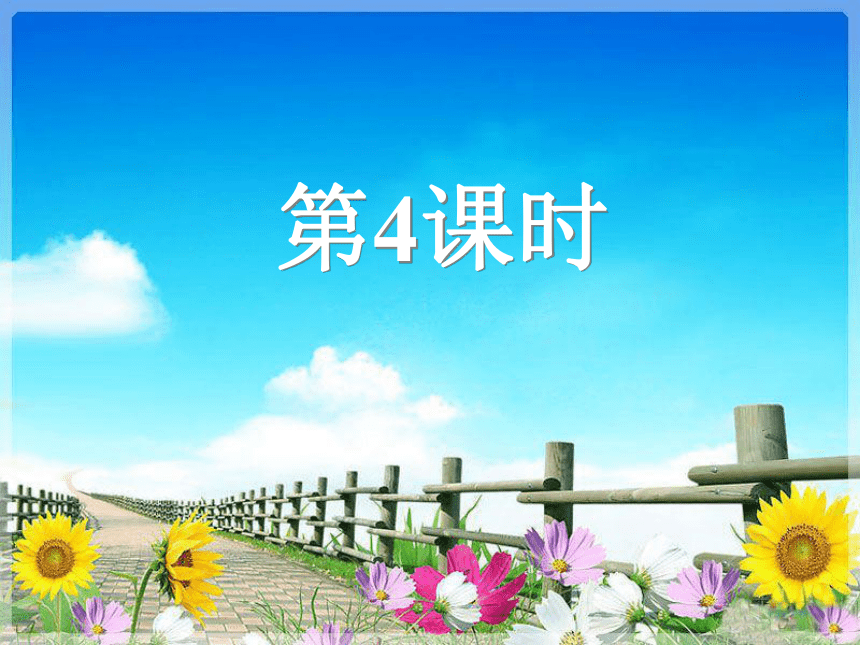
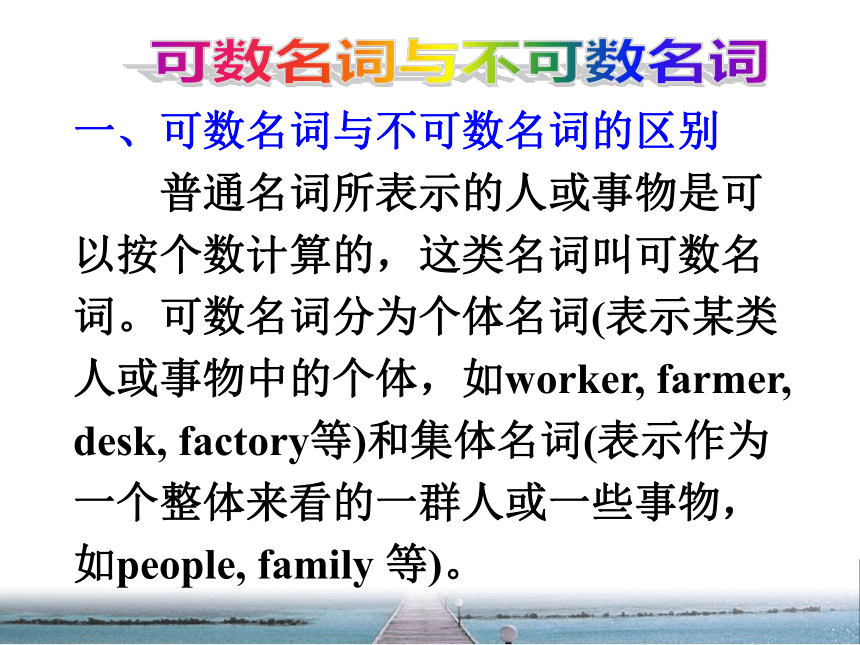
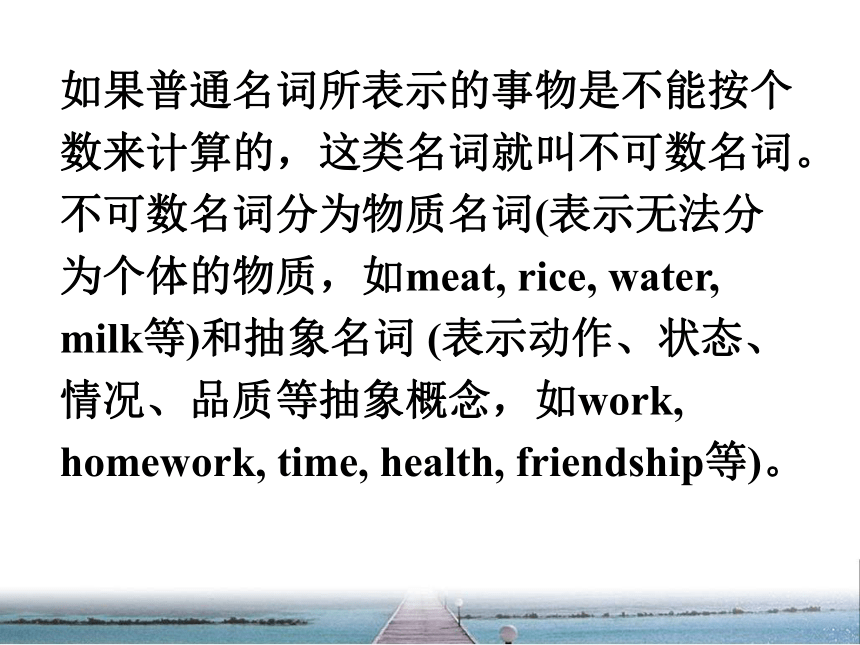
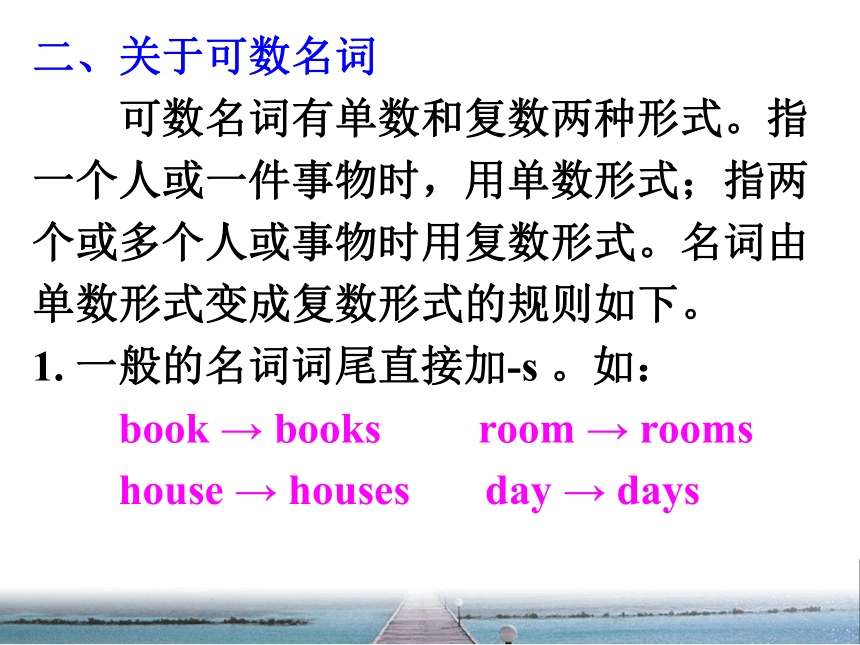

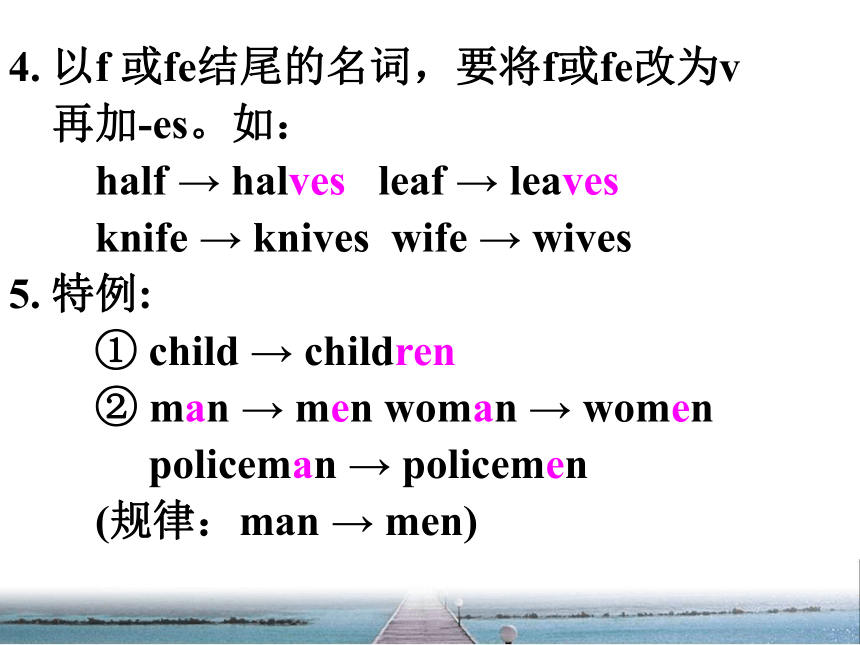
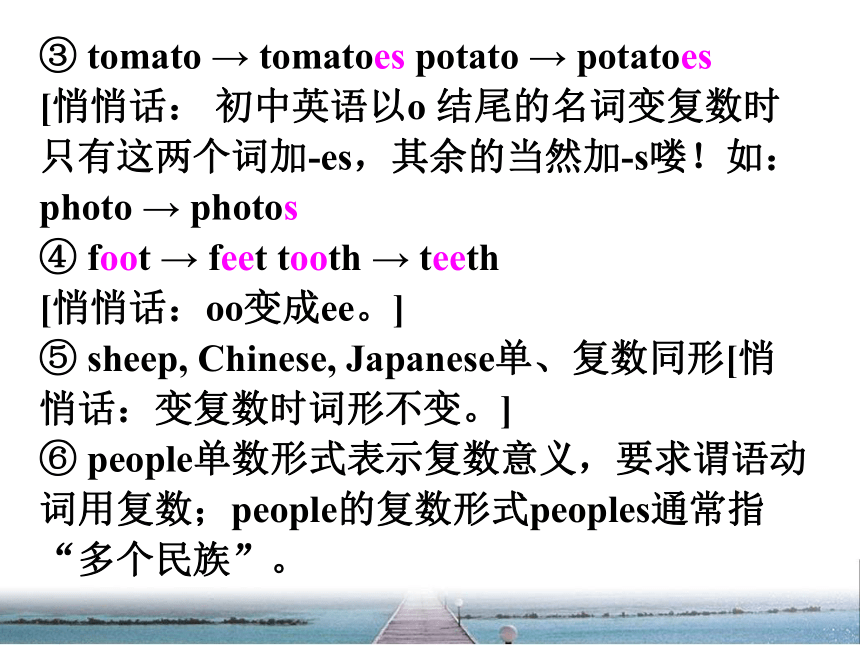
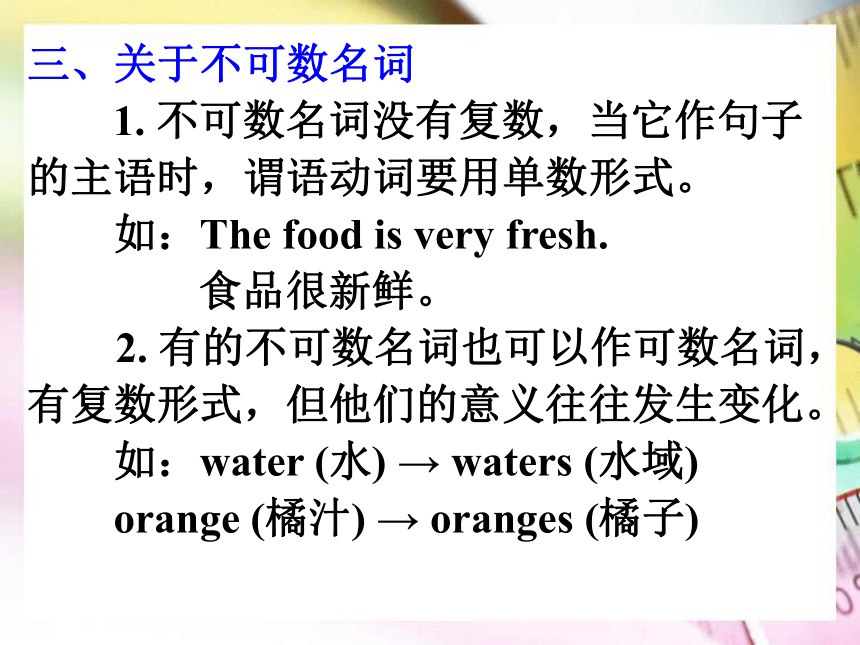
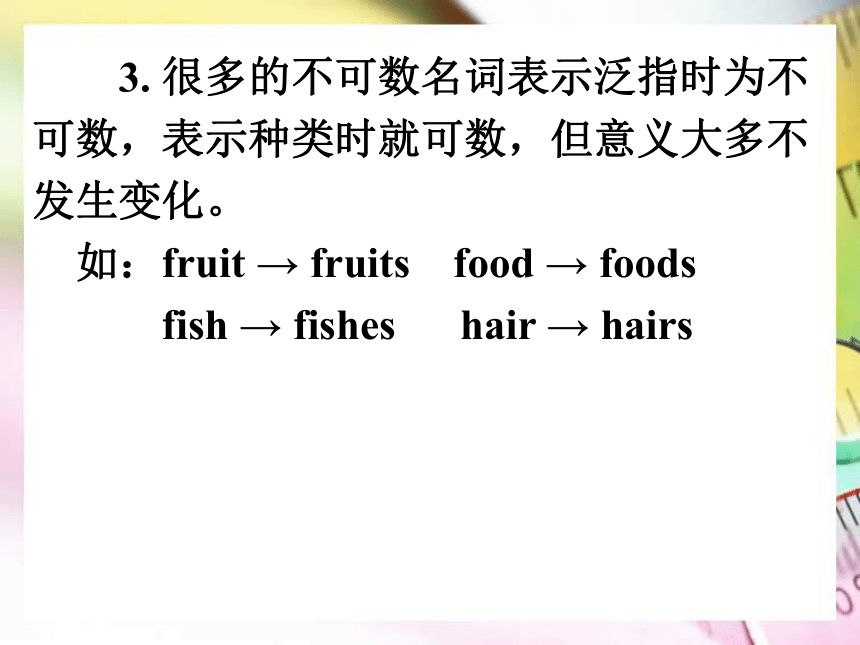
文档简介
课件22张PPT。第4课时一、可数名词与不可数名词的区别
普通名词所表示的人或事物是可以按个数计算的,这类名词叫可数名词。可数名词分为个体名词(表示某类人或事物中的个体,如worker, farmer, desk, factory等)和集体名词(表示作为一个整体来看的一群人或一些事物,如people, family 等)。可数名词与不可数名词如果普通名词所表示的事物是不能按个数来计算的,这类名词就叫不可数名词。不可数名词分为物质名词(表示无法分为个体的物质,如meat, rice, water, milk等)和抽象名词 (表示动作、状态、情况、品质等抽象概念,如work, homework, time, health, friendship等)。二、关于可数名词
可数名词有单数和复数两种形式。指一个人或一件事物时,用单数形式;指两个或多个人或事物时用复数形式。名词由单数形式变成复数形式的规则如下。
1. 一般的名词词尾直接加-s 。如:
book → books room → rooms
house → houses day → days2. 以s, ss, ch, sh, x结尾的名词,在词尾加-
es。如:
bus → buses glass → glasses
watch → watches
dish → dishes box → boxes
3. 以“辅音字母+y”结尾的名词,要先将y
改为i再加-es。如:
city → cities body → bodies
factory → factories等等。4. 以f 或fe结尾的名词,要将f或fe改为v
再加-es。如:
half → halves leaf → leaves
knife → knives wife → wives
5. 特例:
① child → children
② man → men woman → women
policeman → policemen
(规律:man → men)③ tomato → tomatoes potato → potatoes
[悄悄话: 初中英语以o 结尾的名词变复数时只有这两个词加-es,其余的当然加-s喽!如:photo → photos
④ foot → feet tooth → teeth
[悄悄话:oo变成ee。]
⑤ sheep, Chinese, Japanese单、复数同形[悄悄话:变复数时词形不变。]
⑥ people单数形式表示复数意义,要求谓语动词用复数;people的复数形式peoples通常指“多个民族”。三、关于不可数名词
1. 不可数名词没有复数,当它作句子的主语时,谓语动词要用单数形式。
如:The food is very fresh.
食品很新鲜。
2. 有的不可数名词也可以作可数名词,有复数形式,但他们的意义往往发生变化。
如:water (水) → waters (水域)
orange (橘汁) → oranges (橘子) 3. 很多的不可数名词表示泛指时为不可数,表示种类时就可数,但意义大多不发生变化。
如:fruit → fruits food → foods
fish → fishes hair → hairs四、名词可数不可数“几注意”
1、可数名词是可以用来计数的名词。可数名词有单数和复数形式。如:desk-desks, apple-apples等。不可数名词是不可以直接用来计数的名词。不可数名词没有复数形式,如:some bread,a little milk等。 2、可数名词和不可数名词前都可以用some, any, a lot of, lots of 等来修饰,表示"一些,许多"。如:
There are some oranges on the desk. 桌子上有一些桔子。
There is a lot of water in the bottle. 瓶里有许多水。3、可数名词前可用具体的数词来表示具体的数量。如:two apples, four books等。不可数名词前通常用“单位词+of”来表示数量。如:a piece of paper, three pieces of paper等。
4、对可数名词前的修饰语提问用how many; 对不可数名词前的修饰语提问用how much。 如:
How many apples are there in the box?
盒子里有多少个苹果?
How much tea is there in the cup?
杯里有多少茶水?A: I need to buy some food, when will the supermarket close? 我得去买点吃的, 超市什么时候关门?
B: It opens around the clock! 24小时营业。I简单英语购物对话A: Is somebody taking care of you?
B: No. I’d like a long-sleeved shirt in yellow, medium.
A: I think we’re out of your size.
B: Well, can you get me one?
A: I think so. Check back next week.IIA: Is anyone helping you?
B: No. I’m looking for a blue coat, size 34.
A: I’m afraid we don’t have any left.
B: Will you be getting more in?
A: Yes. Try us again next Monday.IIII. 请从各题后所给的选项中选出最佳选项。( ) 1. —What do you think _____ the dress?
—It is very nice, but I don’t like the color.
A. of B. on C. in D. at
( ) 2. Mrs. White ____ to buy a dress ____ her daughter.
A. wants; to B. want; to
C. wants; for D. want; for 练习坊( ) 3. —Would you like ____ orange juice, Mary?
—No, thanks. I don’t want ____ juice now.
A. some; some B. any; any
C. some; any D. any; some( ) 4. How much ____ do you like, John?
A. salt B. eggs
C. vegetables D. apples
( ) 5. —How do you _____ the T-shirt?
—That’s fine. I’ll take it.
A. know B. like
C. take D. look( ) 6. The white T-shirt _______ too long. How about this short _______?
A. is; ones B. are; ones
C. is; one D. are; one
( ) 7. —What about the blue pants?
—Very nice. Why not ______?
A. try on it B. try on them
C. try it on D. try them on( ) 8. — Can you tell me Lucy’s phone number?
— Sorry, I don’t know her phone
number.
—_______.
A. Sure B. Thank you all the same
C. All right D. You’re welcome( ) 9. —How do you say the number “834” in English?
—________.
A. Eight hundreds and three four
B. Eight hundred thirty and four
C. Eight hundred and thirty-four
D. Eight hundreds and thirty-four
普通名词所表示的人或事物是可以按个数计算的,这类名词叫可数名词。可数名词分为个体名词(表示某类人或事物中的个体,如worker, farmer, desk, factory等)和集体名词(表示作为一个整体来看的一群人或一些事物,如people, family 等)。可数名词与不可数名词如果普通名词所表示的事物是不能按个数来计算的,这类名词就叫不可数名词。不可数名词分为物质名词(表示无法分为个体的物质,如meat, rice, water, milk等)和抽象名词 (表示动作、状态、情况、品质等抽象概念,如work, homework, time, health, friendship等)。二、关于可数名词
可数名词有单数和复数两种形式。指一个人或一件事物时,用单数形式;指两个或多个人或事物时用复数形式。名词由单数形式变成复数形式的规则如下。
1. 一般的名词词尾直接加-s 。如:
book → books room → rooms
house → houses day → days2. 以s, ss, ch, sh, x结尾的名词,在词尾加-
es。如:
bus → buses glass → glasses
watch → watches
dish → dishes box → boxes
3. 以“辅音字母+y”结尾的名词,要先将y
改为i再加-es。如:
city → cities body → bodies
factory → factories等等。4. 以f 或fe结尾的名词,要将f或fe改为v
再加-es。如:
half → halves leaf → leaves
knife → knives wife → wives
5. 特例:
① child → children
② man → men woman → women
policeman → policemen
(规律:man → men)③ tomato → tomatoes potato → potatoes
[悄悄话: 初中英语以o 结尾的名词变复数时只有这两个词加-es,其余的当然加-s喽!如:photo → photos
④ foot → feet tooth → teeth
[悄悄话:oo变成ee。]
⑤ sheep, Chinese, Japanese单、复数同形[悄悄话:变复数时词形不变。]
⑥ people单数形式表示复数意义,要求谓语动词用复数;people的复数形式peoples通常指“多个民族”。三、关于不可数名词
1. 不可数名词没有复数,当它作句子的主语时,谓语动词要用单数形式。
如:The food is very fresh.
食品很新鲜。
2. 有的不可数名词也可以作可数名词,有复数形式,但他们的意义往往发生变化。
如:water (水) → waters (水域)
orange (橘汁) → oranges (橘子) 3. 很多的不可数名词表示泛指时为不可数,表示种类时就可数,但意义大多不发生变化。
如:fruit → fruits food → foods
fish → fishes hair → hairs四、名词可数不可数“几注意”
1、可数名词是可以用来计数的名词。可数名词有单数和复数形式。如:desk-desks, apple-apples等。不可数名词是不可以直接用来计数的名词。不可数名词没有复数形式,如:some bread,a little milk等。 2、可数名词和不可数名词前都可以用some, any, a lot of, lots of 等来修饰,表示"一些,许多"。如:
There are some oranges on the desk. 桌子上有一些桔子。
There is a lot of water in the bottle. 瓶里有许多水。3、可数名词前可用具体的数词来表示具体的数量。如:two apples, four books等。不可数名词前通常用“单位词+of”来表示数量。如:a piece of paper, three pieces of paper等。
4、对可数名词前的修饰语提问用how many; 对不可数名词前的修饰语提问用how much。 如:
How many apples are there in the box?
盒子里有多少个苹果?
How much tea is there in the cup?
杯里有多少茶水?A: I need to buy some food, when will the supermarket close? 我得去买点吃的, 超市什么时候关门?
B: It opens around the clock! 24小时营业。I简单英语购物对话A: Is somebody taking care of you?
B: No. I’d like a long-sleeved shirt in yellow, medium.
A: I think we’re out of your size.
B: Well, can you get me one?
A: I think so. Check back next week.IIA: Is anyone helping you?
B: No. I’m looking for a blue coat, size 34.
A: I’m afraid we don’t have any left.
B: Will you be getting more in?
A: Yes. Try us again next Monday.IIII. 请从各题后所给的选项中选出最佳选项。( ) 1. —What do you think _____ the dress?
—It is very nice, but I don’t like the color.
A. of B. on C. in D. at
( ) 2. Mrs. White ____ to buy a dress ____ her daughter.
A. wants; to B. want; to
C. wants; for D. want; for 练习坊( ) 3. —Would you like ____ orange juice, Mary?
—No, thanks. I don’t want ____ juice now.
A. some; some B. any; any
C. some; any D. any; some( ) 4. How much ____ do you like, John?
A. salt B. eggs
C. vegetables D. apples
( ) 5. —How do you _____ the T-shirt?
—That’s fine. I’ll take it.
A. know B. like
C. take D. look( ) 6. The white T-shirt _______ too long. How about this short _______?
A. is; ones B. are; ones
C. is; one D. are; one
( ) 7. —What about the blue pants?
—Very nice. Why not ______?
A. try on it B. try on them
C. try it on D. try them on( ) 8. — Can you tell me Lucy’s phone number?
— Sorry, I don’t know her phone
number.
—_______.
A. Sure B. Thank you all the same
C. All right D. You’re welcome( ) 9. —How do you say the number “834” in English?
—________.
A. Eight hundreds and three four
B. Eight hundred thirty and four
C. Eight hundred and thirty-four
D. Eight hundreds and thirty-four
同课章节目录
- Unit 1 Making new friends
- Topic 1 Welcome to China!
- Topic 2 Where are you from?
- Topic 3 How old are you?
- Unit 2 Looking different
- Topic 1 I have a small nose
- Topic 2 What does she look like?
- Topic 3 Whose jacket is this?
- Unit 3 Getting togethe
- Topic 1 Does he speak Chinese?
- Topic 2 What do your parents do?
- Topic 3 What would you like to drink?
- Unit 4 Having fun
- Topic 1 What can I do for you?
- Topic 2 Would you like to cook with us?
- Topic 3 What time is it now?
